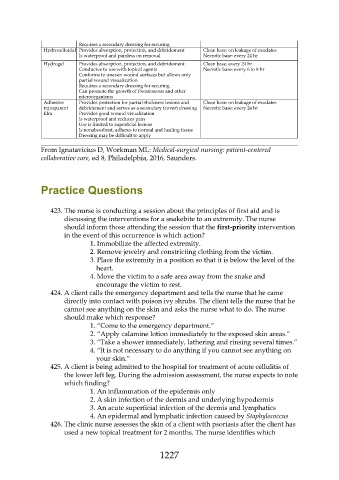Page 1227 - Saunders Comprehensive Review For NCLEX-RN
P. 1227
Requires a secondary dressing for securing
Hydrocolloidal Provides absorption, protection, and debridement Clean base: on leakage of exudates
Is waterproof and painless on removal Necrotic base: every 24 hr
Hydrogel Provides absorption, protection, and debridement Clean base: every 24 hr
Conducive to use with topical agents Necrotic base: every 6 to 8 hr
Conforms to uneven wound surfaces but allows only
partial wound visualization
Requires a secondary dressing for securing
Can promote the growth of Pseudomonas and other
microorganisms
Adhesive Provides protection for partial-thickness lesions and Clean base: on leakage of exudates
transparent debridement and serves as a secondary (cover) dressing Necrotic base: every 24 hr
film Provides good wound visualization
Is waterproof and reduces pain
Use is limited to superficial lesions
Is nonabsorbent, adheres to normal and healing tissue
Dressing may be difficult to apply
From Ignatavicius D, Workman ML: Medical-surgical nursing: patient-centered
collaborative care, ed 8, Philadelphia, 2016, Saunders.
Practice Questions
423. The nurse is conducting a session about the principles of first aid and is
discussing the interventions for a snakebite to an extremity. The nurse
should inform those attending the session that the first-priority intervention
in the event of this occurrence is which action?
1. Immobilize the affected extremity.
2. Remove jewelry and constricting clothing from the victim.
3. Place the extremity in a position so that it is below the level of the
heart.
4. Move the victim to a safe area away from the snake and
encourage the victim to rest.
424. A client calls the emergency department and tells the nurse that he came
directly into contact with poison ivy shrubs. The client tells the nurse that he
cannot see anything on the skin and asks the nurse what to do. The nurse
should make which response?
1. “Come to the emergency department.”
2. “Apply calamine lotion immediately to the exposed skin areas.”
3. “Take a shower immediately, lathering and rinsing several times.”
4. “It is not necessary to do anything if you cannot see anything on
your skin.”
425. A client is being admitted to the hospital for treatment of acute cellulitis of
the lower left leg. During the admission assessment, the nurse expects to note
which finding?
1. An inflammation of the epidermis only
2. A skin infection of the dermis and underlying hypodermis
3. An acute superficial infection of the dermis and lymphatics
4. An epidermal and lymphatic infection caused by Staphylococcus
426. The clinic nurse assesses the skin of a client with psoriasis after the client has
used a new topical treatment for 2 months. The nurse identifies which
1227

